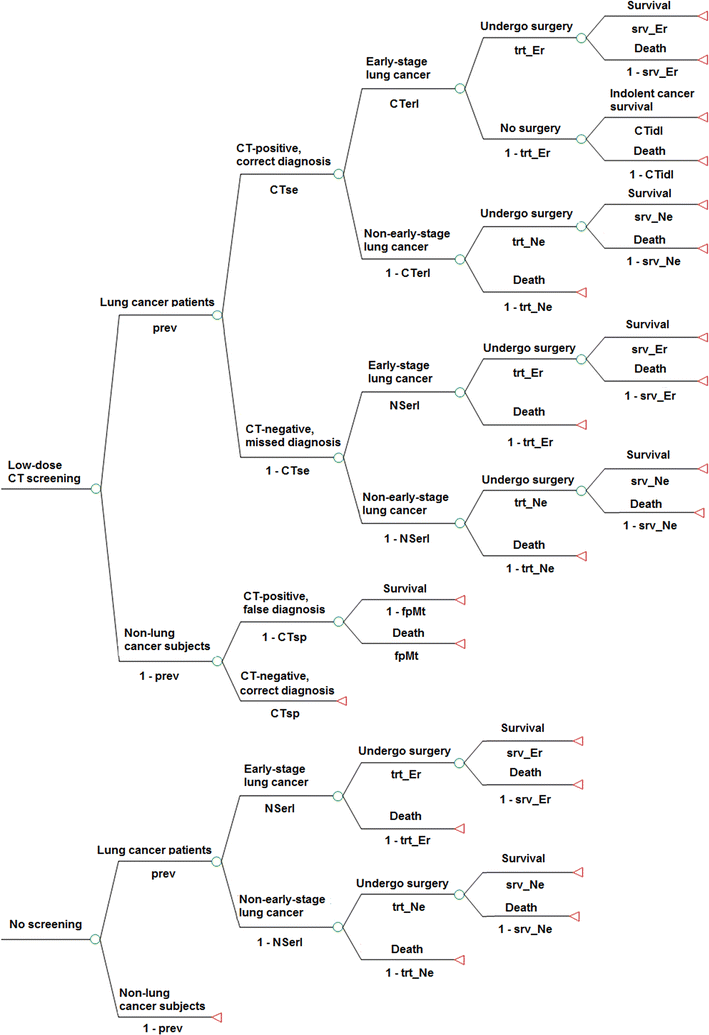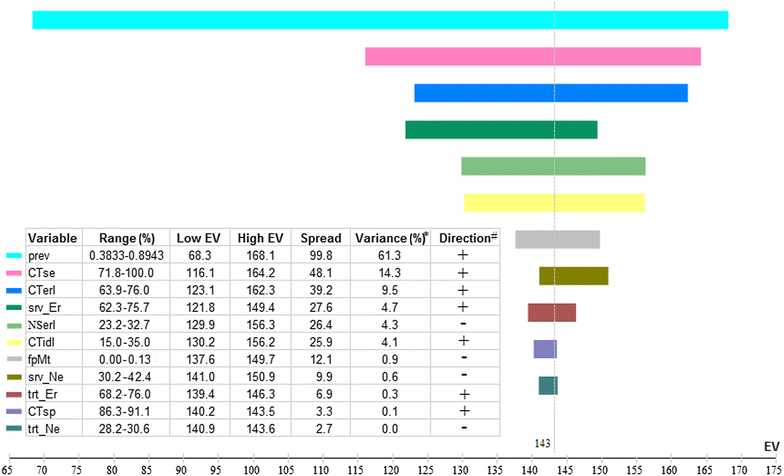Mortality outcomes of low-dose computed tomography screening for lung cancer in urban China: a decision analysis and implications for practice
- PMID: 28709441
- PMCID: PMC5512753
- DOI: 10.1186/s40880-017-0221-8
Mortality outcomes of low-dose computed tomography screening for lung cancer in urban China: a decision analysis and implications for practice
Abstract
Background: Mortality outcomes in trials of low-dose computed tomography (CT) screening for lung cancer are inconsistent. This study aimed to evaluate whether CT screening in urban areas of China could reduce lung cancer mortality and to investigate the factors that associate with the screening effect.
Methods: A decision tree model with three scenarios (low-dose CT screening, chest X-ray screening, and no screening) was developed to compare screening results in a simulated Chinese urban cohort (100,000 smokers aged 45-80 years). Data of participant characteristics were obtained from national registries and epidemiological surveys for estimating lung cancer prevalence. The selection of other tree variables such as sensitivities and specificities of low-dose CT and chest X-ray screening were based on literature research. Differences in lung cancer mortality (primary outcome), false diagnoses, and deaths due to false diagnosis were calculated. Sensitivity analyses were performed to identify the factors that associate with the screening results and to ascertain worst and optimal screening effects considering possible ranges of the variables.
Results: Among the 100,000 subjects, there were 448, 541, and 591 lung cancer deaths in the low-dose CT, chest X-ray, and no screening scenarios, respectively (17.2% reduction in low-dose CT screening over chest X-ray screening and 24.2% over no screening). The costs of the two screening scenarios were 9387 and 2497 false diagnoses and 7 and 2 deaths due to false diagnosis among the 100,000 persons, respectively. The factors that most influenced death reduction with low-dose CT screening over no screening were lung cancer prevalence in the screened cohort, low-dose CT sensitivity, and proportion of early-stage cancers among low-dose CT detected lung cancers. Considering all possibilities, reduction in deaths (relative numbers) with low-dose CT screening in the worst and optimal cases were 16 (5.4%) and 288 (40.2%) over no screening, respectively.
Conclusions: In terms of mortality outcomes, our findings favor conducting low-dose CT screening in urban China. However, approaches to reducing false diagnoses and optimizing important screening conditions such as enrollment criteria for screening are highly needed.
Keywords: Decision analysis; Low-dose CT; Lung cancer; Mortality outcome; Screening.
Figures



Similar articles
-
Benefits and harms of computed tomography lung cancer screening strategies: a comparative modeling study for the U.S. Preventive Services Task Force.Ann Intern Med. 2014 Mar 4;160(5):311-20. doi: 10.7326/M13-2316. Ann Intern Med. 2014. PMID: 24379002 Free PMC article.
-
Screening for Lung Cancer With Low-Dose Computed Tomography: Updated Evidence Report and Systematic Review for the US Preventive Services Task Force.JAMA. 2021 Mar 9;325(10):971-987. doi: 10.1001/jama.2021.0377. JAMA. 2021. PMID: 33687468
-
The effect of direct referral for fast CT scan in early lung cancer detection in general practice. A clinical, cluster-randomised trial.Dan Med J. 2015 Mar;62(3):B5027. Dan Med J. 2015. PMID: 25748876 Clinical Trial.
-
Lung cancer screening with helical computed tomography in older adult smokers: a decision and cost-effectiveness analysis.JAMA. 2003 Jan 15;289(3):313-22. doi: 10.1001/jama.289.3.313. JAMA. 2003. PMID: 12525232
-
Low-dose CT screening can reduce cancer mortality: A meta-analysis.Rev Assoc Med Bras (1992). 2019 Dec;65(12):1508-1514. doi: 10.1590/1806-9282.65.12.1508. Rev Assoc Med Bras (1992). 2019. PMID: 31994634 Review.
Cited by
-
The challenges of implementing low-dose computed tomography for lung cancer screening in low- and middle-income countries.Nat Cancer. 2020 Dec;1(12):1140-1152. doi: 10.1038/s43018-020-00142-z. Epub 2020 Nov 30. Nat Cancer. 2020. PMID: 35121933 Review.
-
Barriers and facilitators of lung cancer screening uptake: protocol of a mixed methods systematic review.BMJ Open. 2022 Apr 15;12(4):e054652. doi: 10.1136/bmjopen-2021-054652. BMJ Open. 2022. PMID: 35428625 Free PMC article.
-
Advances in lung cancer screening and early detection.Cancer Biol Med. 2022 May 11;19(5):591-608. doi: 10.20892/j.issn.2095-3941.2021.0690. Cancer Biol Med. 2022. PMID: 35535966 Free PMC article. Review.
-
Lung cancer LDCT screening and mortality reduction - evidence, pitfalls and future perspectives.Nat Rev Clin Oncol. 2021 Mar;18(3):135-151. doi: 10.1038/s41571-020-00432-6. Epub 2020 Oct 12. Nat Rev Clin Oncol. 2021. PMID: 33046839 Review.
-
Development and validation of qualitative and quantitative models to predict invasiveness of lung adenocarcinomas manifesting as pure ground-glass nodules based on low-dose computed tomography during lung cancer screening.Quant Imaging Med Surg. 2022 May;12(5):2917-2931. doi: 10.21037/qims-21-912. Quant Imaging Med Surg. 2022. PMID: 35502397 Free PMC article.
References
-
- American Cancer Society. Cancer facts & figures 2014. http://www.cancer.org/research/cancerfactsstatistics/cancerfactsfigures2.... Accessed 28 Aug 2016.
MeSH terms
LinkOut - more resources
Full Text Sources
Other Literature Sources
Medical

